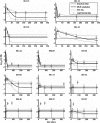Modelling HIV-1 2-LTR dynamics following raltegravir intensification
- PMID: 23658114
- PMCID: PMC3673152
- DOI: 10.1098/rsif.2013.0186
Modelling HIV-1 2-LTR dynamics following raltegravir intensification
Abstract
A model of reservoir activation and viral replication is introduced accounting for the production of 2-LTR HIV-1 DNA circles following antiviral intensification with the HIV integrase inhibitor raltegravir, considering contributions of de novo infection events and exogenous sources of infected cells, including quiescent infected cell activation. The model shows that a monotonic increase in measured 2-LTR concentration post intensification is consistent with limited de novo infection primarily maintained by sources of infected cells unaffected by raltegravir, such as quiescent cell activation, while a transient increase in measured 2-LTR concentration is consistent with significant levels of efficient (R0 > 1) de novo infection. The model is validated against patient data from the INTEGRAL study and is shown to have a statistically significant fit relative to the null hypothesis of random measurement variation about a mean. We obtain estimates and confidence intervals for the model parameters, including 2-LTR half-life. Seven of the 13 patients with detectable 2-LTR concentrations from the INTEGRAL study have measured 2-LTR dynamics consistent with significant levels of efficient replication of the virus prior to treatment intensification.
Keywords: HIV; cryptic viremia; mathematical biology.
Figures



Similar articles
-
Spatial modeling of HIV cryptic viremia and 2-LTR formation during raltegravir intensification.J Theor Biol. 2014 Mar 21;345:61-9. doi: 10.1016/j.jtbi.2013.12.020. Epub 2013 Dec 28. J Theor Biol. 2014. PMID: 24378646 Free PMC article.
-
Episomal HIV-1 DNA and its relationship to other markers of HIV-1 persistence.Retrovirology. 2018 Jan 30;15(1):15. doi: 10.1186/s12977-018-0398-1. Retrovirology. 2018. PMID: 29378611 Free PMC article. Review.
-
No effect of raltegravir intensification on viral replication markers in the blood of HIV-1-infected patients receiving antiretroviral therapy.J Acquir Immune Defic Syndr. 2012 Mar 1;59(3):229-35. doi: 10.1097/QAI.0b013e31823fd1f2. J Acquir Immune Defic Syndr. 2012. PMID: 22083073 Free PMC article. Clinical Trial.
-
Increase in 2-long terminal repeat circles and decrease in D-dimer after raltegravir intensification in patients with treated HIV infection: a randomized, placebo-controlled trial.J Infect Dis. 2013 Nov 1;208(9):1436-42. doi: 10.1093/infdis/jit453. Epub 2013 Aug 23. J Infect Dis. 2013. PMID: 23975885 Free PMC article. Clinical Trial.
-
[Potential of integrase inhibitors to deplete HIV reservoirs or prevent their replenishment].Enferm Infecc Microbiol Clin. 2008 Nov;26 Suppl 12:17-22. doi: 10.1016/s0213-005x(08)76568-6. Enferm Infecc Microbiol Clin. 2008. PMID: 19572421 Review. Spanish.
Cited by
-
HIV 2-LTR experiment design optimization.PLoS One. 2018 Nov 8;13(11):e0206700. doi: 10.1371/journal.pone.0206700. eCollection 2018. PLoS One. 2018. PMID: 30408070 Free PMC article.
-
Mathematical Models of HIV Latency.Curr Top Microbiol Immunol. 2018;417:131-156. doi: 10.1007/82_2017_77. Curr Top Microbiol Immunol. 2018. PMID: 29164341 Free PMC article. Review.
-
Persistent HIV-1 Viremia on Antiretroviral Therapy: Measurement and Mechanisms.Front Microbiol. 2019 Oct 15;10:2383. doi: 10.3389/fmicb.2019.02383. eCollection 2019. Front Microbiol. 2019. PMID: 31681237 Free PMC article. Review.
-
Cardiac and Renal Comorbidities in Aging People Living With HIV.Circ Res. 2024 May 24;134(11):1636-1660. doi: 10.1161/CIRCRESAHA.124.323948. Epub 2024 May 23. Circ Res. 2024. PMID: 38781295 Free PMC article. Review.
-
Next-Generation Sequencing in a Direct Model of HIV Infection Reveals Important Parallels to and Differences from In Vivo Reservoir Dynamics.J Virol. 2020 Apr 16;94(9):e01900-19. doi: 10.1128/JVI.01900-19. Print 2020 Apr 16. J Virol. 2020. PMID: 32051279 Free PMC article.
References
-
- Hatano H, Vogel S, Yoder C, Metcalf JA, Dewar R, Davey RT, Polis MA. 2000. Pre-HAART HIV burden approximates post-HAART viral levels following interruption of therapy in patients with sustained viral suppression. AIDS 14, 1357–136310.1097/00002030-200007070-00008 (doi:10.1097/00002030-200007070-00008) - DOI - DOI - PubMed
-
- Chun TW, Davey RT, Ostrowski M, Shawn Justement J, Engel D, Mullins JI, Fauci AS. 2000. Relationship between pre-existing viral reservoirs and the re-emergence of plasma viremia after discontinuation of highly active anti-retroviral therapy. Nat. Med. 6, 757–76110.1038/77481 (doi:10.1038/77481) - DOI - DOI - PubMed
-
- Chun TW, Davey RT, Engel D, Lane HC, Fauci AS. 1999. Re-emergence of HIV after stopping therapy. Nature 401, 874–87510.1038/44755 (doi:10.1038/44755) - DOI - DOI - PubMed
-
- Davey R, et al. 1999. HIV-1 and T cell dynamics after interruption of highly active antiretroviral therapy (HAART) in patients with a history of sustained viral suppression. Proc. Natl Acad. Sci. USA 96, 15 109–15 11410.1073/pnas.96.26.15109 (doi:10.1073/pnas.96.26.15109) - DOI - DOI - PMC - PubMed
-
- Wong JK, Hezareh M, Günthard HF, Havlir DV, Ignacio CC, Spina CA, Richman DD. 1997. Recovery of replication-competent HIV despite prolonged suppression of plasma viremia. Science 278, 1291–129510.1126/science.278.5341.1291 (doi:10.1126/science.278.5341.1291) - DOI - DOI - PubMed
Publication types
MeSH terms
Substances
Grants and funding
LinkOut - more resources
Full Text Sources
Other Literature Sources
Medical

